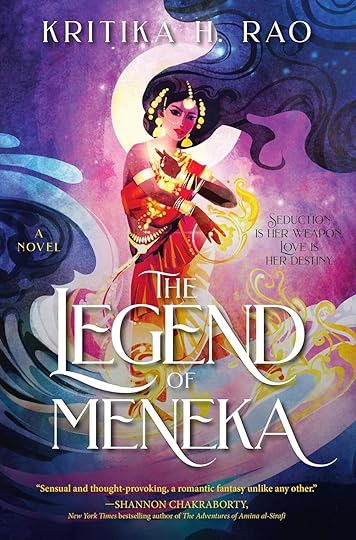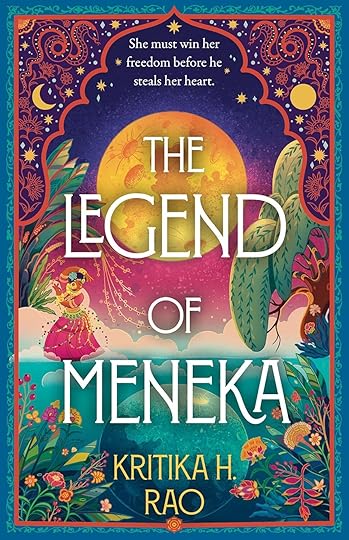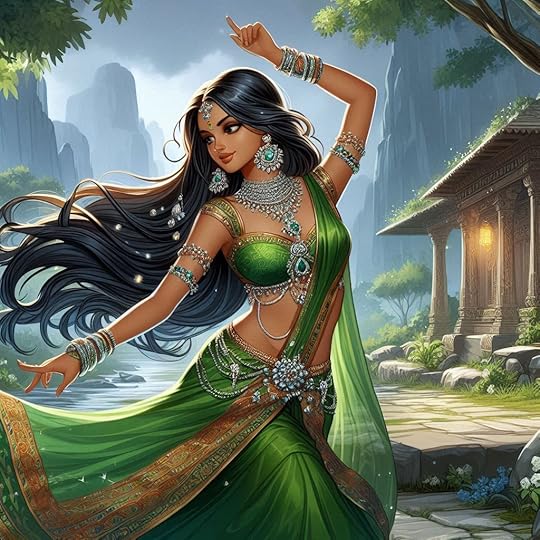The Legend of Meneka by Kritika H. Rao - Book Review
Series: The Divine Dancers Duology #1 (Cliffhanger)
Publication Date: 21st Jan 2025
Genre: Hindu Puranic Retelling
4.5 Stars
One Liner: Full stars for the Shiva chapter

Meneka is one of the apsaras of Indra’s court and apowerful weapon. Her power is the art of seduction – to use dance and illusionto defeat Indra’s enemies and prevent heaven from losing its magic. However,Meneka no longer wants to do this. She wants to stay in Amaravathi, Indra’skingdom, and use her talents there.
However, Indra offers her a deal – seduce Kaushikaand prove her devotion to Amaravthi to get what she wants. Meneka agreesknowing the new mission is near impossible. Kaushika may have become a sage buthe was a well-feared Kshatriya with warrior instincts. By channeling the sameintensity, he became a sage with tremendous magic intent on waging waragainst Indra.
Will Meneka be successful in her mission or will sheget more than what she bargained for and at what cost?
The story comes in Meneka’s first-person POV in thepresent tense.
My Thoughts:Though I’m wary of retellings exploring HinduPuranic and Ithihasic stories, I did want to try this after someone recommendedthe author’s previous books. The lower rating scared and worried me. NGL, Ipostponed this to read closer to the pub date as I didn’t want a repeat ofKaikeyi.
Patel’s Kaikeyi is nothing more than a distorted andcolonized take on something sacred to my culture. All those comparing Legend ofMeneka to that nonsense in a perfumed package have absolutely missed all thenuances that make this a Hindu book. The sad state is that even the officialpromotion does it!
Moreover, marketing this book using popular tropeshas done it a disservice. I know, readers need a checklist these days; the tagsare important; the comparisons are important; even more than the book itself.But, a book is much more than its tropes.
Enemies to lovers, romantasy, cozy fantasy, spicy,et al… well, the tags are right but only if you know the core context. Otherwise,these won’t make sense or feel incorrect.
Legend of Meneka is not just lust, seduction, orspice. It is an exploration of sringara and Kama at physical, emotional,spiritual, and cosmic levels. It is the celebration of the union of divinemasculine and divine feminine without which this universe wouldn’t exist. Whenit talks of Shiva and Shakti in terms of lingam and yoni, it transcends themortal desire for flesh and sexual gratification. It is the pulsing life thatensures the universe thrums with neverending energy to preventself-destruction. Without the union of Shiva and Shakti, there is no life, noprana, no jeeva, and no prakriti. Love is too small a word to encompass therelationship of Shiva and Shakti. They are two halves of a whole, theArdhanareeshwara, the perfect balance of divine masculine and divinefeminine.
 Though the author uses the word lust in the story,she switches to the actual term in her note –Kama. Lust doesn’t define Kama asit is only a part of it. Kama is one of the Purusharthas (Dharma, Artha, Kama,and Moksha) and a part of our lives. We have only reduced their true meaningswith our incorrect translations to English. Lust might be a sin but Kama isnecessary and has to be balanced with Dharma and Artha to travel the path toMoksha (Artha and Kama have to be discarded at the appropriate stage).Kama is not limited to physical and material aspects; it never has been.
Though the author uses the word lust in the story,she switches to the actual term in her note –Kama. Lust doesn’t define Kama asit is only a part of it. Kama is one of the Purusharthas (Dharma, Artha, Kama,and Moksha) and a part of our lives. We have only reduced their true meaningswith our incorrect translations to English. Lust might be a sin but Kama isnecessary and has to be balanced with Dharma and Artha to travel the path toMoksha (Artha and Kama have to be discarded at the appropriate stage).Kama is not limited to physical and material aspects; it never has been.
When something so intricate and integral to Hinduismis removed from its framework, the result is a diluted and surface-levelnarrative that limits the story to the physical realm. Those unfamiliar withthe core details miss out on the nuance; it doesn’t exist for them. It’s muchlike how yoga became a billion-dollar industry of stretching exercises withfancy and exotic names. It has no soul. Similarly, when the Hindu framework isremoved/ ignored/ avoided, this book ends up as a weak YA story of a whinyheroine and a grumpy hero.
Before I dive into the details, let me share a shortversion of the original. This isn’t an individual story but is mentioned indifferent places as a part of the backstory.
Summary of the OriginalMeneka is one of the three celestial apsaras –Rambha, Urvashi, and Meneka. They live in Indra’s kingdom (heaven with acapital city named Amaravati) and dance in his court for entertainment (theirsand others). They are also spies and seducers whenever necessary.
Kaushika aka Vishwamitra is a king who left hisKshatriya dharma to become the best rishi in the world. He wanted to becomeBrahmarishi (think of it as a topmost title) and be called this byVashishta. Kaushika as a king once visited Vashishta’s ashram, and somethinghappened. This makes him determined to be the greatest rishi (never mindthat the concept of being a rishi is to denounce such traits, somethinghe learns after a long time). He attains a higher state through penance butloses it when he helps a king called Trishanku by creating an exclusive heavenfor him. He starts fresh again and wants to show Indra and others what he iscapable of.
Indra isn’t going to sit idle, right? He sendsMeneka to disrupt Kaushika’s penance. If Kaushika had really given up worldlypleasures, he wouldn’t be swayed and might become worthy of the title he seeks.If not, well…

Meneka goes to seduce Kaushika and the result istheir baby girl Shakuntala. Meneka leaves the newborn outside Rishi Kanva’sashram and returns to heaven. Kaushika starts his tapasya once again, finallyproves his worth, and becomes Vishwamitra the Brahmarishi.
The cookie-cutter version makes it seem likeKaushika and Meneka had a one-nighter or a fling. However, it was likely to bean affair that lasted a solid few months or years that ended with Meneka’spregnancy/ Shakuntala’s birth.
The second half dealing with Indra sending Meneka toKaushika is provided as a backstory in Shakuntala’s story in the Mahabharata(Adi Parva). The first half can be found in the Ramayana.
The author took different versions of this story andused creative liberties to spin a tale of magic, love, lust, seduction, andpower strongly rooted in Hinduism.
While her MMC retained the core traits of Kaushika,she gave her own spin to Meneka (which is where I believe things went a bitsouth).
CharactersKaushika is a Kshatriya turned Brahmin. The blend ofboth has given him an advantage and a disadvantage. I don’t use the terms inthe ‘caste’ sense. Not even varna or jati. I talk of them as gunas (personalitytraits). A Kshatriya is a warrior born and trained to protect, rule, govern,and spends most of his years as a grihasta (a married man). A Brahmin is leanerborn and trained to study, acquire knowledge, gain wisdom, and attain a balanceof mind that prevents partiality, pride, anger, and grief. It’s a life-longtapasya to constantly improve oneself; not for accolades but for the peace feltwhen one separates themselves from the rest of the world.
Those who know Vishwamitra (even the movies/ TVversion should be enough) can easily see Kaushika. The aloof grumpy herowith a temper is not an archetype. It is him. It is who he is, and hasalways been. The author retained his essence perfectly. I had zero issues visualizinghim as I read the book. She did the same for Indra – who can be a hero, villain,or both. He is a complicated deva with an abundance of grey shades. After all,he is my god even if he is not my God. Rambha is much like how I expectan apsara to be.
She did the same for Indra – who can be a hero, villain,or both. He is a complicated deva with an abundance of grey shades. After all,he is my god even if he is not my God. Rambha is much like how I expectan apsara to be. I think the issue lies with Meneka’scharacterization. Since we don’t get much information about her, the authorcreated someone vulnerable and naïve possibly to showcase her growth. A greatidea. However, the execution makes her sound whiny at times. While I can seeher conflict, I don’t think it makes much sense when you ignore the Hinduframework. She pales as a new adult who whines and cries and cannot decide whatto do. But within the framework, she presents the conflict of dharma. I thinkusing the word loyalty in place of devotion for Indra might have helped.
ThemesThe book deals with many themes like loyalty, love,friendships, devotion, dharma, etc. The core of it is finding oneself. Iwouldn’t have minded if Meneka found herself earlier than she did. I preferstrong FMCs, so there have been instances when I wanted to shake sense intoher. Still, when it happened, it was beautiful. Diversity is another theme thatblends with everything else. The devas would hardly bother with the genderrules humans like to define! They accept everything as natural. Beautiful!
The book has spice but only around 2.5. That may notbe enough for those who want a spice romantasy. It works for me as I can seethe elements of sringara rasa, which is integral to my culture. It is one ofthe nava rasas (nine flavors, to put it loosely). It blends romance,love, lust, desire, seduction, sensuality, and erotica but is a lot more thanthese. English really doesn’t do justice to the word. There’s no exacttranslation. For an apsara, sringara is in every fiber of her being. She is it.In the book, their interactions are a heady blend of everything with a gooddose of vulnerability. Maybe more spice might have helped but it is notnecessary. What we get here is a slow dance where every move is full oferoticism that stems from genuine feelings.
World-building and Magic SystemThe world-building is also Hindu. It is colorful,vibrant, rich, and full of life. Be it Amaravati or Kaushika’s ashram, opulenceor earthiness, everything is inherent to my culture. Even though the choice ofkurta-pajama as costumes took a while to get used to, the saris, jewelry,topknots, dhoti, etc., are familiar and comforting.
I love the use of scents to describe the characters.I could feel and smell them. Star anise for Rambha – what a choice! Potent andspicy, exciting and mysterious, and a touch of sweetness with a bite that candraw blood; most importantly, best in small quantities or it will overpower thedish.

Magic is inherent to our essence. It is the pranathat keeps us hoping and living. In the book, magic comes from prana (thesource of life). It is represented by the elements (fire, wind, water,and earth), the pancha bhootas that sustain life.
While it may seem silly for ‘love’ to be the key, itis apt. It is the truth. For an apsara, it is the most vital differentiatingfactor. The key couldn’t have been anything else. Nothing would make senseother than love. It is this love that resulted in the birth of Shakuntala.
I could easily visualize every scene in the book, beit the setting, the intimacy, the dance, or the magic. It helps that I knowwhat a Kalpavriksha is or what Sri Yantra looks like. Not being familiar withthese elements will make a difference to your reading experience.
Shiva and EndingI’m not a crier when I read books. I read too manywords a day for them to touch my heart. So, when a book makes me teary-eyed, Igive it grace marks. But this made me cry; not for the characters, though. I wasa little annoyed by Meneka by then.
The tears had everything to do with Shiva in thatone chapter. The tears are a response to the beauty of love for Shiva. Theauthor must be a Shiv bhakt. You cannot fake bhakti like this (at least Ithink it cannot be). Words carry intentions that seep through at somepoint. All I feel here is love and devotion that comes from deep trust; notsomething we are expected to display but something that’s a part of our soul. Ican only pray I’m right. If book two proves me otherwise, it’ll be a lesson Ihave to learn.
The ending is open since the whole thing willconclude in the sequel. Meneka has decent growth, so I hope it sustains andincreases in the next book instead of crashing to zero and starting again. Thestakes are high, and I prefer we have a heroine capable of more transparencyand self-reflection. Don’t turn her into a new adult again. Let her continue tobloom. And… give us a beautiful chapter with Shakti.
To summarize, The Legend of Meneka is an unapologeticallyHindu story filled with symbolism from my culture. Not many will understand thenuances. But I wouldn’t have it any other way.
There’s a glossary at the beginning (a great idea)and the final version will have a map as well. Don’t miss the author’s note. Itmight help understand the book a little more (if you couldn’t).
Thank you, NetGalley, and Harper Voyager, for eARC.
#NetGalley #TheLegendOfMeneka



